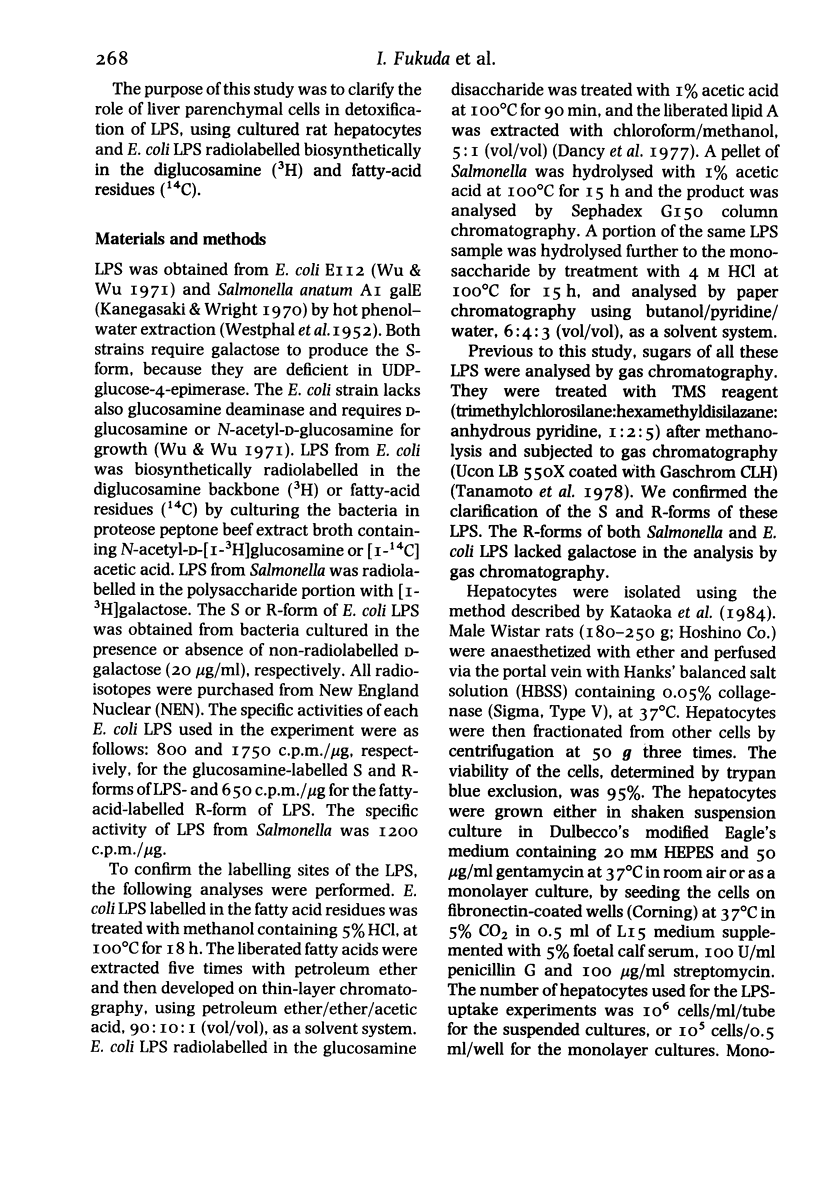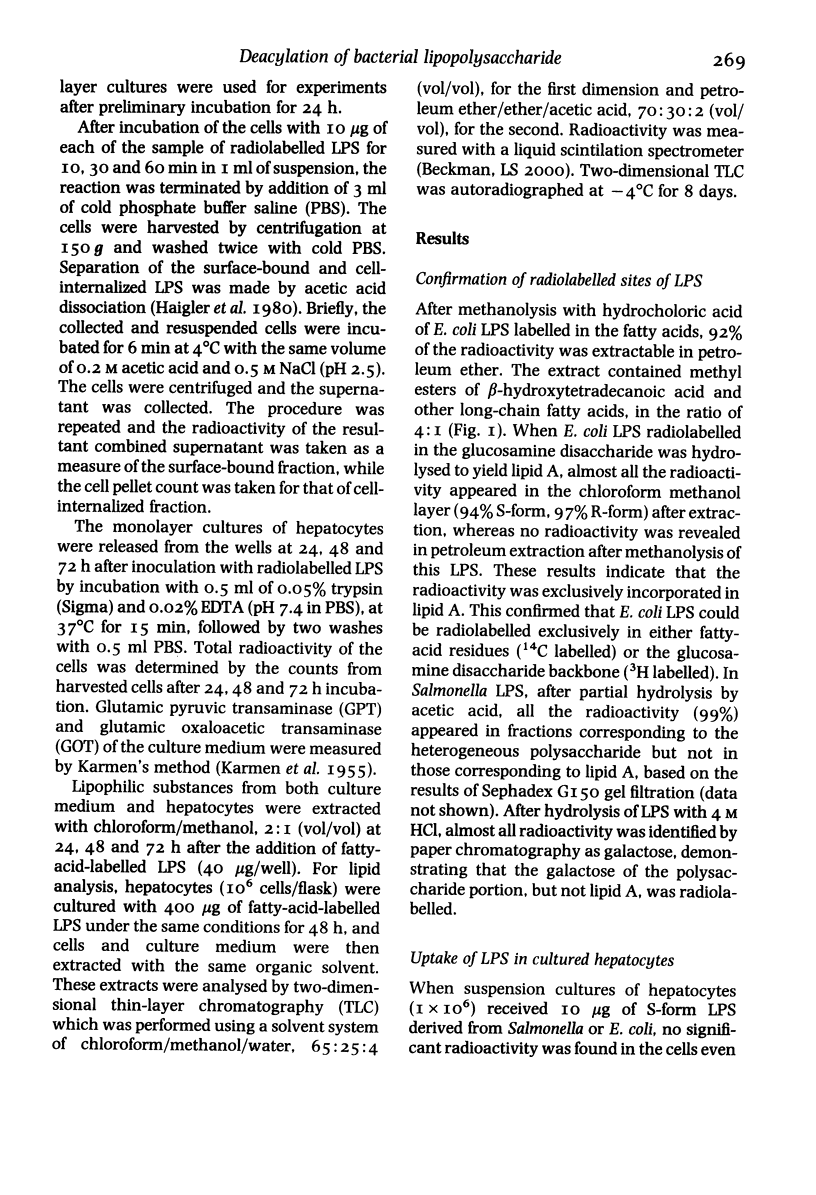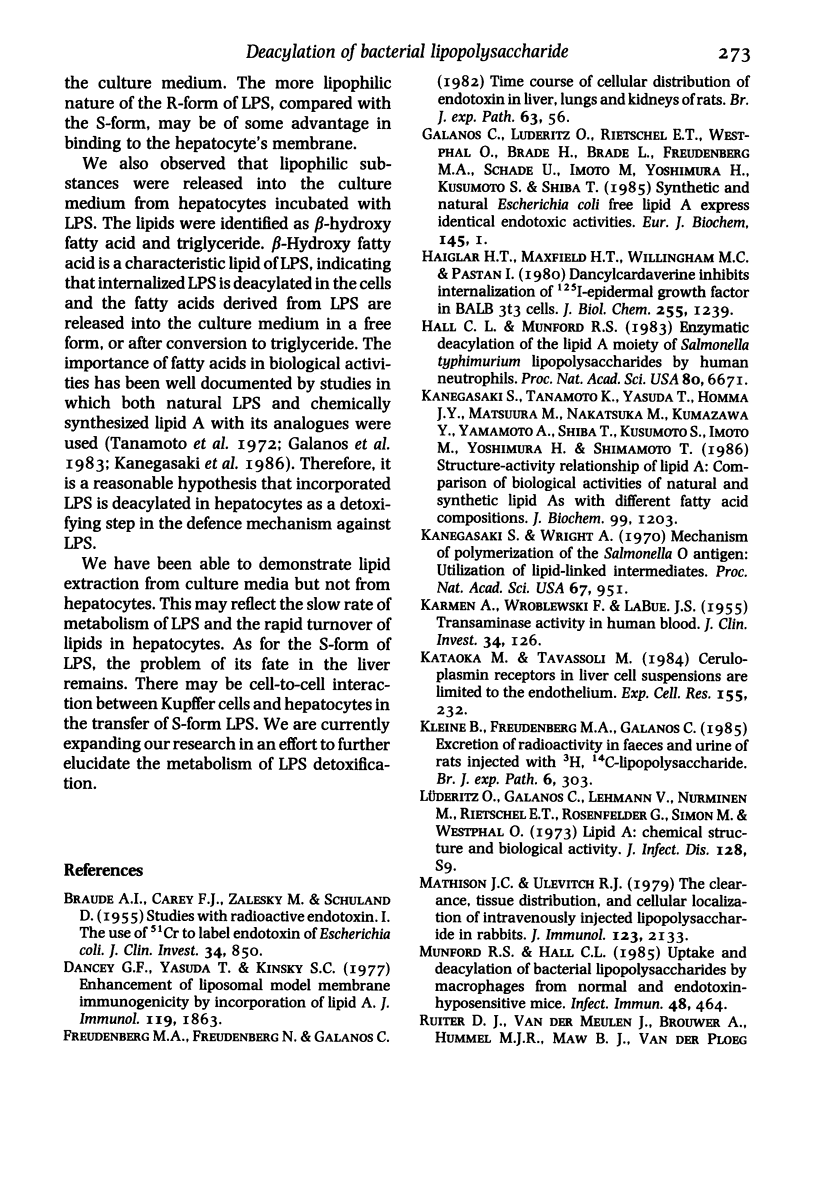Abstract
The possible role of liver parenchymal cells in the uptake and degradation of bacterial lipopolysaccharide (LPS) was investigated in vitro by employing radiolabelled LPS as substrate. Hepatocytes obtained from Wistar rats by collagenase treatment were found to take up LPS only when it was not linked to the polysaccharide of O-antigen. The amount of LPS taken up increased with time and after 48 h incubation it increased in a dose-dependent manner up to at least 30 micrograms. When incubated with LPS radiolabelled exclusively in the fatty-acid moiety, cultured hepatocytes released lipophilic materials into the culture medium. These were identified as beta-hydroxytetradecanoic acid and triglyceride, in the ratio of 7:I. These results indicate that the R-form of LPS which lacks the O-antigen polysaccharide is taken up and deacylated in hepatocytes, and the derived fatty acids are released into the culture medium either in the free form or after conversion to triglyceride.
Full text
PDF







Images in this article
Selected References
These references are in PubMed. This may not be the complete list of references from this article.
- Freudenberg M. A., Freudenberg N., Galanos C. Time course of cellular distribution of endotoxin in liver, lungs and kidneys of rats. Br J Exp Pathol. 1982 Feb;63(1):56–65. [PMC free article] [PubMed] [Google Scholar]
- Haigler H. T., Maxfield F. R., Willingham M. C., Pastan I. Dansylcadaverine inhibits internalization of 125I-epidermal growth factor in BALB 3T3 cells. J Biol Chem. 1980 Feb 25;255(4):1239–1241. [PubMed] [Google Scholar]
- Hall C. L., Munford R. S. Enzymatic deacylation of the lipid A moiety of Salmonella typhimurium lipopolysaccharides by human neutrophils. Proc Natl Acad Sci U S A. 1983 Nov;80(21):6671–6675. doi: 10.1073/pnas.80.21.6671. [DOI] [PMC free article] [PubMed] [Google Scholar]
- Kanegasaki S., Tanamoto K., Yasuda T., Homma J. Y., Matsuura M., Nakatsuka M., Kumazawa Y., Yamamoto A., Shiba T., Kusumoto S. Structure-activity relationship of lipid A: comparison of biological activities of natural and synthetic lipid A's with different fatty acid compositions. J Biochem. 1986 Apr;99(4):1203–1210. doi: 10.1093/oxfordjournals.jbchem.a135583. [DOI] [PubMed] [Google Scholar]
- Kanegasaki S., Wright A. Mechanism of polymerization of the Salmonella O-antigen: utilization of lipid-linked intermediates. Proc Natl Acad Sci U S A. 1970 Oct;67(2):951–958. doi: 10.1073/pnas.67.2.951. [DOI] [PMC free article] [PubMed] [Google Scholar]
- Kleine B., Freudenberg M. A., Galanos C. Excretion of radioactivity in faeces and urine of rats injected with 3H,14C-lipopolysaccharide. Br J Exp Pathol. 1985 Jun;66(3):303–308. [PMC free article] [PubMed] [Google Scholar]
- Mathison J. C., Ulevitch R. J. The clearance, tissue distribution, and cellular localization of intravenously injected lipopolysaccharide in rabbits. J Immunol. 1979 Nov;123(5):2133–2143. [PubMed] [Google Scholar]
- Munford R. S., Hall C. L. Uptake and deacylation of bacterial lipopolysaccharides by macrophages from normal and endotoxin-hyporesponsive mice. Infect Immun. 1985 May;48(2):464–473. doi: 10.1128/iai.48.2.464-473.1985. [DOI] [PMC free article] [PubMed] [Google Scholar]
- Tanamoto K., Abe C., Homma J. Y., Kojima Y. Regions of the lipopolysaccharide of Pseudomonas aeruginosa essential for antitumor and interferon-inducing activities. Eur J Biochem. 1979 Jul;97(2):623–629. doi: 10.1111/j.1432-1033.1979.tb13152.x. [DOI] [PubMed] [Google Scholar]
- Yamaguchi Y., Yamaguchi K., Babb J. L., Gans H. In vivo quantitation of the rat liver's ability to eliminate endotoxin from portal vein blood. J Reticuloendothel Soc. 1982 Dec;32(6):409–422. [PubMed] [Google Scholar]
- Zlydaszyk J. C., Moon R. J. Fate of 51Cr-labeled lipopolysaccharide in tissue culture cells and livers of normal mice. Infect Immun. 1976 Jul;14(1):100–105. doi: 10.1128/iai.14.1.100-105.1976. [DOI] [PMC free article] [PubMed] [Google Scholar]



